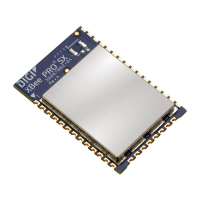Work with networked devices Test links between adjacent devices
XBee®/XBee-PRO SX RF Module User Guide
159
frames can be sent by either device A, device B or device C and in all cases the test is the same: device
A sends data to device B and reports the results.
RSSI indicators
The received signal strength indicator (RSSI) measures the amount of power present in a radio signal.
It is an approximate value for signal strength received on an antenna.
You can use the DB command to measure the RSSI on a device. DB returns the RSSI value measured in
-dBm of the last packet the device received. This number can be misleading in multi-hop DigiMesh
networks. The DB value only indicates the received signal strength of the last hop. If a transmission
spans multiple hops, the DB value provides no indication of the overall transmission path, or the
quality of the worst link, it only indicates the quality of the last link.
To determine the DB value in hardware:
1. Use the RSSI module pin (pin 7). When the device receives data, it sets the RSSI PWM duty cycle
to a value based on the RSSI of the packet it receives.
This value only indicates the quality of the last hop of a multi-hop transmission. You could connect this
pin to an LED to indicate if the link is stable or not.
Discover all the devices on a network
You can use the ND (Network Discovery)command to discover all devices on a network. When you
send the ND command:
1. The device sends a broadcast ND command through the network.
2. All devices that receive the command send a response that includes their addressing
information, node identifier string and other relevant information. For more information on the
node identifier string, see NI (Node Identifier).
ND is useful for generating a list of all device addresses in a network.
When a device receives the network discovery command, it waits a random time before sending its
own response. You can use the NT command to set the maximum time delay on the device that you
use to send the ND command.
n The device that sends the ND includes its NT setting in the transmission to provide a delay
window for all devices in the network.
n The default NT value is 0x82 (13 seconds).
Discover devices within RF range
n You can use the FN (Find Neighbors) command to discover the devices that are immediate
neighbors (within RF range) of a particular device.
n FN is useful in determining network topology and determining possible routes.
You can send FN locally on a device in Command mode or you can use a local AT Command Frame -
0x08.
To use FN remotely, send the target node a Remote AT Command Request frame - 0x17 using FN as
the name of the AT command.
The device you use to send FN transmits a zero-hop broadcast to all of its immediate neighbors. All of
the devices that receive this broadcast send an RF packet to the device that transmitted the FN
command. If you sent FN remotely, the target devices respond directly to the device that sent the FN

